COCHRANE, ONTARIO — Last year Detour Gold’s (TSX: DGC) Detour Lake mine in northeastern Ontario was the second-largest gold producer in Canada. It’s now on track to take the top spot.
Detour Lake — a large-scale, open-pit operation with a 23-year mine life — sits 300 km northeast of Timmins and 185 km by road northeast of Cochrane. It hosts reserves of 16.4 million oz. (514.3 million tonnes at 0.99 gram gold per tonne). That’s more than double the reserves of its nearest competitor Canadian Malartic at 7.8 million oz. (221.5 million tonnes at 1.08 grams gold). Agnico Eagle Mines (TSX: AEM; NYSE: AEM) and Yamana Gold (TSX: YRI; NYSE: AUY) jointly own Canadian Malartic, near Val-d’Or, Que.
In 2015, Detour’s flagship asset recorded annual production of 505,558 ounces. This put it behind Canadian Malartic’s 571,618 ounces.
This year Detour Lake should produce 540,000 to 590,000 oz., while Canadian Malartic expects 572,000 oz. gold. Meanwhile, Goldcorp’s (TSX: G; NYSE: GG) Red Lake mine in Ontario forecasts 2016 production of 300,000 to 330,000 oz. gold, and Agnico’s Meadowbank mine in Nunavut anticipates 305,000 oz. gold.
But taking Canada’s largest gold-producer title is secondary to the company, which is focused on improving its bottom line.
“I don’t care to be the largest. I want to be the most profitable,” Paul Martin, Detour’s president and CEO, tells The Northern Miner on a flight from Toronto to Cochrane during a June site visit.

Detour Gold’s mine general manager Charles Hennessey (second from right) talks to analysts in the mill at the Detour Lake gold mine in northeastern Ontario. Photo by Salma Tarikh.
“Chasing ounces isn’t what it’s all about,” he explains during the two-hour chartered flight, which also carries 40 analysts.
Detour Lake started making cash in the fourth quarter of 2015, and investors and analysts are waiting to see what’s next, Martin says. “They’re always eager for growth … what we’ve said in the short term is that we are going to focus on the operation, make sure we continue to make money and optimize what we have.”
Its second priority is to look for organic growth on the large 625 sq. km claim block. The contiguous land package hosts the West Detour pit and the high-grade Zone 58N, among other targets. “Our exploration budget is US$12 million this year,” Martin says. “We now have an eight-year program to systematically evaluate this property.” This program aims to find high-grade satellite gold deposits within trucking distance of the mill.
The company’s third priority is to lower its debt. “When I took over as CEO, we had $680 million in debt. We now have $425 million in debt. Our only piece of debt matures in November 2017. We want to get at or below $300 million.”
Martin — who was previously chief financial officer— became interim CEO in November 2013, after founder Gerald Panneton resigned. Three months later, the chartered accountant permanently filled Panneton’s role.
‘From the bottom to the top’
While 2016 is shaping up to be a great year for Detour, the company has had its share of headaches.
In 2006, Detour agreed to buy the Detour Lake property from Pelangio Mines for $75 million, mostly in shares, conditional on completing an initial public offering. It listed on the Toronto Stock Exchange on Jan. 31, 2007, after issuing 10 million shares at $3.50 apiece.

Mining activity at Detour Gold’s Detour Lake gold mine in Ontario. Photo by Salma Tarikh.
Before Pelangio, Placer Dome operated a small open-pit and underground operation at the Detour Lake property. From 1983 to 1999, the operation churned out 1.8 million oz. gold from 14.3 million tonnes grading 3.82 grams gold.
Due to declining gold prices and poor economics, Placer stopped mining in mid-1999.
Commenting on the former operation, Martin notes that Placer selectively mined high grades of up to 6 grams gold and had difficulty processing it. “They said it was a ‘bad’ mine — that was its original image.”
To reinvent this image, Detour Gold spent its early years aggressively drilling the property.
From 2007 to 2009, it completed over 333,200 metres of delineation drilling and tabled an encouraging prefeasibility study. (Those metres increased to more than 541,000 by the end of 2011).
It completed a positive feasibility study in May 2010 that outlined an open-pit mine producing 649,000 oz. annually over a 16-year life, using reserves of 11.4 million ounces. Since then, the reserves have grown 4.6 million oz. and the mine plan has undergone two revisions, with the latest in January 2016.
“The reason why it works now is because we’re not trying to mine just high grade. If you try to selectively mine this out — it wouldn’t work,” Martin says.
After the 2010 feasibility, Detour began permitting activities and strengthening its ties with the local First Nations. That November, it received approval to build the estimated $1.5-billion project.
Pierre Beaudoin, the company’s chief operating officer, who has spent three years in his current role and another three years in charge of building the mine, recalls how hard it was getting Detour Lake online.
“As you see me, I’m 27 years old. And in the first three years, I got 15 years older,” he jokes on the two-hour bus ride. The property is accessible year-round via Provincial Highway 652 from Cochrane. “The construction was tough,” he adds in a more serious tone.
“We were a young company with essentially no money, and we needed to build a project of $1.5 billion. We didn’t have money, we didn’t have the experience and we didn’t have the people. But somehow we managed to get the money, get the people and get the experience. So we did it,” he chuckles.
When Detour brought its initial investors on-site, Beaudoin recalls that there were only trees. “So we planted a Canadian flag where the gyrator would be. And we planted a Canadian flag where the end of the processing plant would be. In our best English, we told them that the plant would be built there and we would do 20 million tonnes.”
Detour’s conviction proved strong. During 2010 and 2011, Martin led a $2-billion debt and equity raise, mainly to cover Detour Lake’s construction costs.
The company poured its first gold in February 2013, after 27 months of construction. Commercial production followed that September.
Despite the initial euphoria, Detour struggled to ramp up the processing plant to nameplate capacity of 55,000 tonnes per day.
In 2013 — its first year of production — Detour revised its guidance three times. It delivered 232,287 oz., including pre-commercial output. Over the year, its share price plunged from $24.89 to $4.10.
Martin says the share price drop resulted from a lot of factors, including a decline in gold prices and the operation failing to meet expectations, coupled with the sudden departure of founder Panneton.
Martin says the company had a hard time opening up the pit because it lacked the proper equipment, among other things. This led to processing lower grades, as well as lower production. The mill also had a few operational issues.
“The project was larger than we gave it credit,” Martin admits. It was the second time in recent history that a junior developed such a large mine in Canada, following Osisko Mining’s Canadian Malartic mine, which started production in 2011. Three years later, Osisko sold its 55,000-tonne-per-day operation to Agnico and Yamana.
In 2014, Detour revised its guidance once. It delivered 456,634 oz., within the low end of its forecast, and continued to tweak the operation.
It wasn’t until March 2015 that the plant surpassed its nameplate capacity. Throughput averaged 56,400 tonnes per day for the last 10 months of 2015. The higher throughput led to record production of 505,558 ounces. All-in sustaining costs and total cash costs were US$1,056 and US$775 per ounce. This marked a 16% and 18% improvement over 2014.
Martin, however, describes 2015 as a year of predictability at the mill versus stability.
Regardless, investors applauded the firm’s progress, pushing its shares at year-end to $14.41, marking a 52% increase over its 2014 close of $9.49, and a 251% increase over 2013. Detour shares continue to climb in 2016 to exit June 21 at $29.64.
Ramping up Detour Lake
On site, Detour Lake’s sheer size is apparent. So far, Detour has mined 100 metres of the pit, with mining slated to go down to more than 700 metres. (To put that in perspective, the CN Tower is 553.3 metres tall.) The pit is also being widened.
Based on a life-of-mine (LOM) plan published in January, the operation will include the nearby West Detour deposit — formerly known as Block A — and processing low-grade fines in the operation’s 23-year mine life.
West Detour hosts 1.5 million oz. in reserves and sits 1 km from the existing pit. The company plans to spend US$8 million this year on permitting, environmental and technical consultation. It expects to file an environmental assessment in the third quarter.
The deposit — estimated to cost US$80 million to build — should come online in 2019, following stripping in 2018. It has a 10-year operating life (2018 to 2028).
The LOM plan also assumes processing up to 1 million tonnes a year of low-grade fines, averaging 0.44 gram gold, beginning in 2019. (Detour is looking to see if it can improve the low-grade fines and implement this process even earlier.)
The mine plan assumes a gradual ramp up between 2016 and 2019, where throughput should climb from 56,000 tonnes per day (20 million tonnes a year) to 63,000 tonnes per day (23 million tonnes a year).
Average annual production should come in at 617,000 oz. in the next three years. Over the LOM, annual output should average 655,000 ounces.
Estimated total site costs from 2016 to 2018 are US$812 per oz., and US$690 per oz. for the LOM.
To the delight of many investors, Detour has hit its targeted 2019 plant throughput in recent weeks.
After providing a tour of the large processing plant, mine general manager Charles Hennessey touches upon the recent improvements.
In April 2016, Detour upgraded the 410-conveyor system, which is responsible for moving ore throughout the processing facility. It replaced the original steel belt with two fabric belts that are cheaper and easier to maintain. The conveyor — previously a major source of downtime — now runs faster. Tonnes per operating hour have climbed from 3,800 to 4,600, with the miner testing the upper limit of 5,000.
After the upgrade the plant processed an average 64,462 tonnes per day between April 21 and May 31, including 13 days at above 70,000 tonnes per day. This is ahead of the LOM target of 63,000 tonnes per day for 2019.
“We think we are going to achieve that much faster. But when it’s going to be exactly, we cannot say,” chief operating officer Beaudoin says. “In the last six weeks, we have been operating at that level already. ‘Can we maintain that?’ is the big question.”
It is early, but Detour expects to provide an update with its second-quarter results.
In the short-term, if the plant outperforms the mine, Detour plans to supplement the plant with its run-of-mine, medium-grade stockpile. The stockpile sits at 134,000 oz. (6.6 million tonnes at 0.63 gram) and is not included in the LOM plan.
Meanwhile, Detour is running a 100,000-tonne test to confirm if screening the medium-grade stockpile for fines of less than 2 inches would double the average grade from 0.65 to 1.3 grams gold. Previous survey results have shown that grades improve 100%, while tonnage increases 30%.
If the results are positive, Detour could immediately process the medium-grade ore, and add 20,000 to 25,000 oz. of low-cost production a year. The results — including operating costs and productivity — are due in the third quarter.
For 2016, Detour maintains its annual guidance of 540,000 to 590,000 oz., at all-in sustaining costs of US$840 to US$940 per oz., including total cash costs of US$675 to US$750 per oz. Quarterly output should range between 125,000 and 150,000 ounces.
In this year’s first quarter, Detour delivered 127,136 oz., at the low-end of the quarterly guidance. The mill processed 52,165 tonnes per day, which is below the design rate due to limited power draw on one of the semi-autogenous grinding (SAG) mills, and processing of coarser material. The SAG mill is now back to full power following the planned shutdown in April.
Growth opportunities
On the exploration front, the miner is focusing on the Lower Detour trend — more specifically the Zone 58N, which sits 7 km southwest of the pit.
“While the market does not appear to attribute material value for the exploration upside, Zone 58N in particular appears to generate interest as a potential source of high-grade [5 to 6 grams gold per tonne] feed for the mill,” Canaccord Genuity analysts Rahul Paul and Alex Pernin write in a research note.
Detour has drilled 37,000 metres of its slated 60,000-metre program this year at Zone 58N. The rest of the drilling should conclude this summer. During that time, it will also drill another 5,000 to 7,000 metres to test other targets along the 25 km Lower Detour trend and the surrounding tailings facility.
“A lot of companies are going on about organic growth. It’s obviously the cheapest bang for your buck. It’s the way to go,” Jean François Métail, Detour’s vice-president of mineral resource management, says during a presentation on site.
“We feel that for us, organic growth has a little bit more ‘oomph’ in that we have 23 years of mine life. We have 23 years to find more mineralization and bring it to our mill … a lot of companies have five to six years in a typical life-of-mine. We’ve got a lot of time to do exploration on our ground.”
Detour might also look to acquire an early stage project as part of its near-term growth strategy, Martin says, adding that he is not in a rush to “buy something.”
Asked if the mine could become an acquisition target, the executive acknowledges this risk, but says he’s “not in it to sell it.”
Instead, he aims to grow the company from an intermediate gold producer to a major producer.
“We have this engine. We have this property. Can we develop the next large gold company in Canada? You need a cornerstone asset, and we have that,” Martin says.

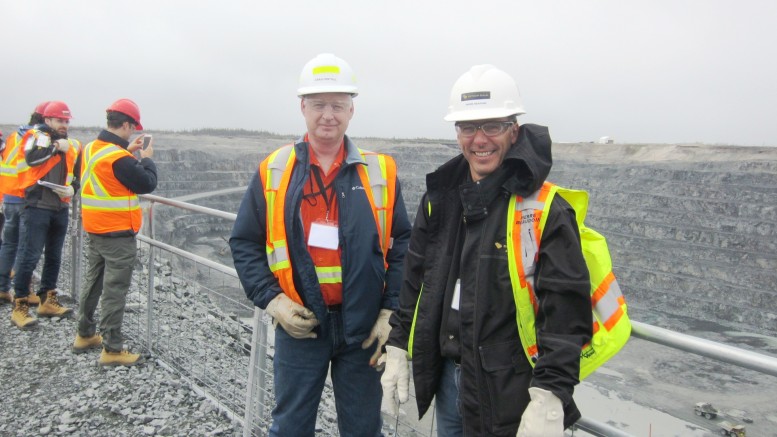
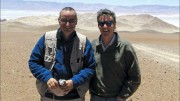
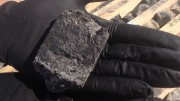
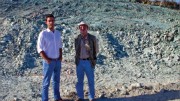
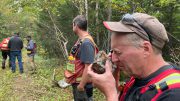
Be the first to comment on "Site visit: Detour revs up Detour Lake mine"